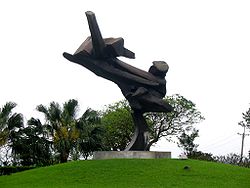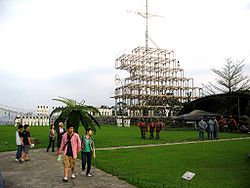
Ju Ming
Encyclopedia



Taiwanese people
Taiwanese people may refer to individuals who either claim or are imputed cultural identity focused on the island of Taiwan and/or Taiwan Area which have been governed by the Republic of China since 1945...
sculptor, who attained fame in Taiwan
Taiwan
Taiwan , also known, especially in the past, as Formosa , is the largest island of the same-named island group of East Asia in the western Pacific Ocean and located off the southeastern coast of mainland China. The island forms over 99% of the current territory of the Republic of China following...
in the 1970s, and in New York
New York
New York is a state in the Northeastern region of the United States. It is the nation's third most populous state. New York is bordered by New Jersey and Pennsylvania to the south, and by Connecticut, Massachusetts and Vermont to the east...
in 1983. Ju Ming was trained as a woodcarver, apprenticed to Lee Chin-chuan, as a teenager. He developed his skill, and applied it to a range of media, including bronze
Bronze
Bronze is a metal alloy consisting primarily of copper, usually with tin as the main additive. It is hard and brittle, and it was particularly significant in antiquity, so much so that the Bronze Age was named after the metal...
, styrofoam
Styrofoam
Styrofoam is a trademark of The Dow Chemical Company for closed-cell currently made for thermal insulation and craft applications. In 1941, researchers in Dow's Chemical Physics Lab found a way to make foamed polystyrene...
, ceramics, and stainless steel
Stainless steel
In metallurgy, stainless steel, also known as inox steel or inox from French "inoxydable", is defined as a steel alloy with a minimum of 10.5 or 11% chromium content by mass....
.
In 1959, he moved back to Tunghsiao and opened his own studio with apprentices, creating a successful crafts business which left him dissatisfied. He became more artistic and tried innovative techniques. Ju married Chen Fu-mei, who is also from Tunghsiao, three years later.
After winning several awards in the prestigious Taiwan Provincial Art Exhibition, Ju felt that he could only develop further as a sculptor if he re-apprenticed himself, this time to Yang Yu-Yu, who himself had only just returned from a three-year art scholarship in Rome. Yang agreed, impressed by "Ju's flowing lines through the natural grain of the wood, the form executed with such an assured gentleness and humility."
In 1976, Ju took up T'ai chi on Yang's advice to develop physical and mental discipline. He developed greatly from this practice and started thinking about sculpting works on the theme of T'ai chi, which had never been done before. Ju's solo exhibition occurred in March at the National Museum of History in Taipei thanks to Yang Yu-yu who convinced the museum authorities to show his student's pieces. It was highly successful and he was named as one of the Ten Outstanding Youths of 1976.
From 1980, Ju continued to gain international acclaim and exhibited abroad. He started The Living World "family" which he continues to expand. These bright figures are made of bronze, stainless steel, painted wood and foam rubber cast bronze, giving him freedom to depict the human form in all its varieties. Another is his "Living World" series, depicting figures drawn from a modern, westernised society. Much of Ju Ming's work is housed at the Juming Museum, just outside Taipei
Taipei
Taipei City is the capital of the Republic of China and the central city of the largest metropolitan area of Taiwan. Situated at the northern tip of the island, Taipei is located on the Tamsui River, and is about 25 km southwest of Keelung, its port on the Pacific Ocean...
. The museum was built at the artist's expense, and is open to the public. He was awarded the 18th Fukuoka Asian Culture Prize
Fukuoka Asian Culture Prize
The is an award established by Fukuoka City and the Yokatopia Foundation to honor the outstanding work of individuals or organizations in preserving or creating Asian culture...
in 2007.
External links
- Juming Museum
- Ju Ming Taichi & Ceramics at Plum Blossoms gallery
- Ju Ming Taichi series sculptures at Buschlen Mowatt gallery
- Ju Ming Living World series sculptures at the Singapore Art Museum (2004)
- Ju Ming at Alisan Gallery (Hong Kong)
- Chinese Tradition and Modernity in Metal Sculpture
- ArtNet article on Ju Ming, with list of exhibitions.
- ThingsAsian article on Ju Ming
- Solo exhibition of Ju Ming's Living World series: White Painted Sculptures and Collages Painting 17.11.2008 - 06.12.2008 (Singapore)

